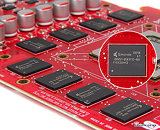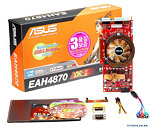Tuesday, September 2nd 2008

ASUS Released Non-Reference Radeon HD 4870 with Expanded Power Circuitry
ASUS has released a non-reference version of the ATI Radeon HD 4870 graphics card. The model is called EAH 4870 D5 and it's main difference is the enhanced power circuitry. The card uses a 4 phase vGPU power circuit along with a 2 phase vMem circuit, making it similar to that of the PowerColor HD 4870 PCS+, while the reference design uses 3 + 2 phases. The PCB uses a 100% conductive polymer capacitor design. The same Qimonda memory chips as those used on reference design boards rounds up the card.
The card runs at reference speeds of 750 MHz Core / 900 MHz Memory. ASUS used its signature Glaciator Fansink cooler for the GPU, which can already be found on many of their other cards but decided to leave the memory chips without active or passive cooling. Expreview notes that the heatsink on the MOSFETs looks small and could be a cause for concern since temperatures of that zone of video cards in general could reach as high as 110 degrees Celsius. The card uses single slot expansion bracket though the card itself requires two slots worth space due to the heatsink. This release follows several other designs from the likes of Palit, PowerColor, etc., that have similar power circuitry, presumably to facilitate better overclocks though poor cooling designs implemented by these AIBs mar the effort put in to design these superior PCBs.
Source:
STcom Korea
The card runs at reference speeds of 750 MHz Core / 900 MHz Memory. ASUS used its signature Glaciator Fansink cooler for the GPU, which can already be found on many of their other cards but decided to leave the memory chips without active or passive cooling. Expreview notes that the heatsink on the MOSFETs looks small and could be a cause for concern since temperatures of that zone of video cards in general could reach as high as 110 degrees Celsius. The card uses single slot expansion bracket though the card itself requires two slots worth space due to the heatsink. This release follows several other designs from the likes of Palit, PowerColor, etc., that have similar power circuitry, presumably to facilitate better overclocks though poor cooling designs implemented by these AIBs mar the effort put in to design these superior PCBs.





35 Comments on ASUS Released Non-Reference Radeon HD 4870 with Expanded Power Circuitry
I do wish they would have put heat sinks on the memory though.
This offering from Asus looks like a total joke, as far as VRM cooling goes. I'd expect more from Asus...
Were are you getting your information from?
btarunr was sloppy and typed "700" instead of "750"...
;)
EastCoasthandle,
You're getting tad entangled in your quotes...
-high ambient temps
-an enclosed case
-little to no ventilation/active cooling
As far as no cooling on the GDDR5, I'm starting to think the clock limits are reached before the temperature limits. Even the Palit card hit 1100MHz without problem (which is more than enough bandwidth anyway).
Does GDDR5 really run that much cooler?